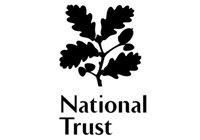- Home
- Haunted Castles
- Haunted Castles in Scotland
Spooky Castles in Scotland
Scotland is well known for its castles, with over a thousand of them dotted all over the Scottish landscape. Many have creepy stories and mysterious tales to tell of fairies, monsters, spirits and the supernatural, each harbouring its own eerie secrets. These restless souls wander staircases and dungeons, corridors and towers of some of Scotlands most famous and infamous castles.
Life in Scotland in the 14th and 15th centuries must have been quite gruesome and terrifying at times. There were many bloody battles and killings, murders, suicides, torture and more, no wonder that quite a few lonely spirits still live within the ancient walls of so many castles.
You may believe in spirits and ghosts, you might be rather skeptical or you simply find ghost tales good for a bit of fun. Whichever category you find yourself in I hope you enjoy learning about the haunted Scottish castles featured here.
CRATHES CASTLE
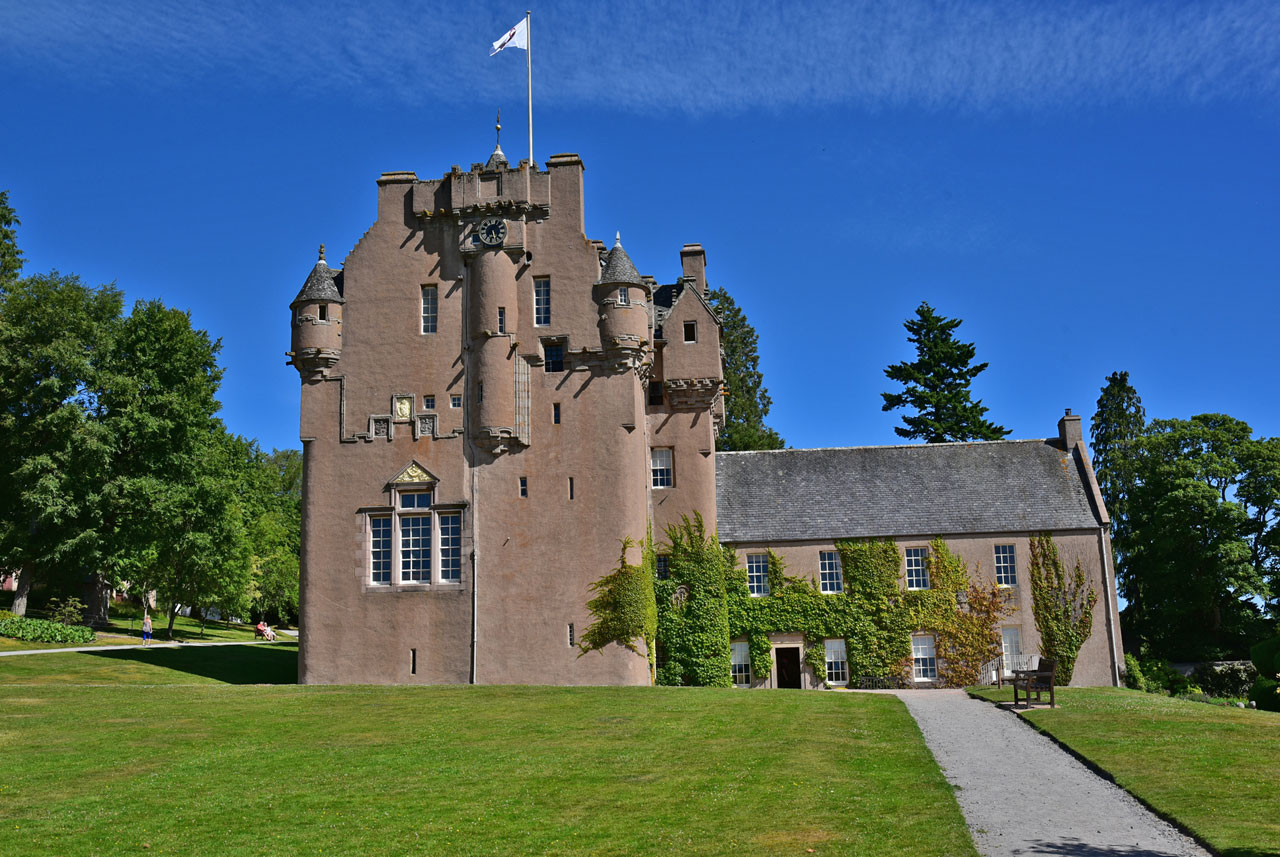
Crathes Castle is situated near Banchory, Aberdeenshire, and has enchanting turrets, towers and ornate rooms. The castle was built in 1553 and has many treasures. The most historic treasure is the Horn of Leys, a jewelled ivory horn which Robert the Bruce gave to the Burnett family who owned the castle until 1966. It was then that Sir James Burnett presented Crathes Castle to the National Trust of Scotland.
There are most certainly spirits inhabiting this historical castle within the walls. The castle ghost is the Green Lady of Crathes. She has been known to glide across the room that is named after her, The Green Lady's Room. Each time she appeared she would cross the room to an ancient carved fireplace where she would lift up a child, after which she would fade away.
During 18th century renovations to the castle, workmen unearthed the bones of a child beneath a hearthstone in The Green Lady's Room.
Location: Crathes, Banchory AB31 5QJ
Official Website: Crathes Castle
CULZEAN CASTLE
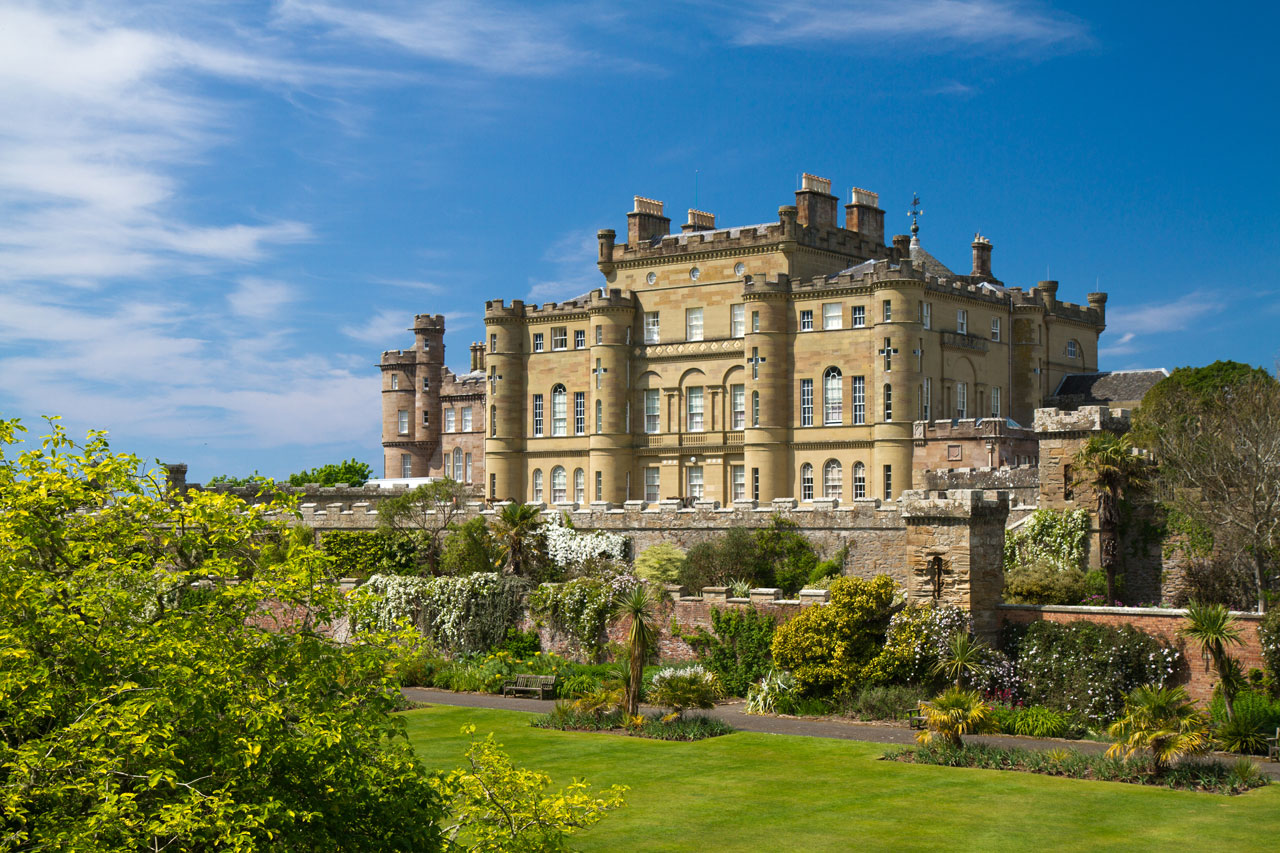
Culzean Castle can be found near Maybole, in Ayrshire. It is situated next to the sea on a cliff top setting with mysterious caves located below the castle. It was designed by the architect Robert Adam in the late 18th century for David Kennedy, 10th Earl of Cassillis, who was keen to impress with his wealth and status.
Culzean Castle is a typical product of the 18th century Picturesque style. Special features include the Round Drawing Room with its fine plaster ceilings, the magnificent oval staircase and the National Guest Flat reserved for General Eisenhower as his Scottish Residence. In 1945 the Kennedy family gave the castle to the National Trust for Scotland as a gift.
Culzean has its fair share of ghost stories. One of the most famous stories is that of the piper who, together with his dog, was sent into the caves below the castle. His mission was to work his way from the entrance below the castle to an exit on a hill some distance away to prove to local residents that the caves weren't haunted. The piper never made it to the exit and he and his dog simply vanished. Legend has it that on the eve of a Kennedy family wedding the sound of pipes can be heard from the caves below the castle and a lone figure can be seen standing on Piper's Brae.
The State Bedroom is thought to be the most haunted room in the castle and the infamous painting of Margaret Erskine of Dun, wife of the 12th Earl of Cassillis, later the 1st Marquess of Ailsa, makes anyone looking at the painting very uncomfortable. Her foot and eyes follow people around the room and a strange mist has been said to emanate from the picture. There is also a young girl who is seen running down the corridors close to the kitchen while a black spectre has been spotted on the stairs from the ground floor to the first.
Thankfully, the castle has plenty else to offer other than spooky sightings. Culzean Castle has been named as a fantastic day out for all the family where you can explore lush, expansive gardens and take a look at the castle itself. Culzean is also available to hire for events including weddings and corporate functions.
Location: Maybole KA19 8LE
Official Website: Culzean Castle
FYVIE CASTLE
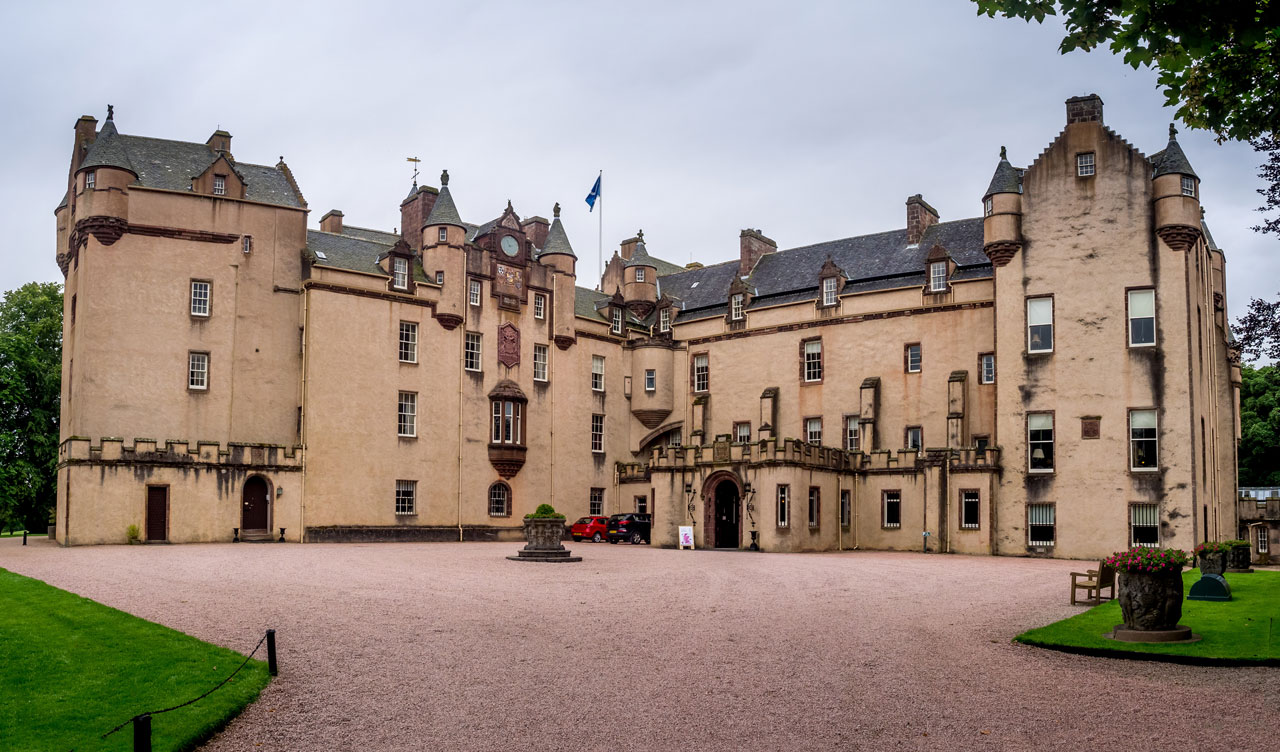
This magnificent 800-year-old castle was once a Royal residence and played host to Robert the Bruce and King Charles I. The sumptuous interior was created by Lord Leith who bought Fyvie in 1889. He amassed a collection of arms and armour as well as impressive artworks including works by Raeburn and Gainsborough.
Over the centuries five families - Preston, Meldrum, Seton, Gordon and Leith - helped create this spellbinding stronghold of rambling corridors and magnificent rooms. Fyvie Castle is now run by the National Trust of Scotland but still has the feel of a family home and the ghosts and legends that surround it have given the castle an air of mystery.
Fyvie is home to the ghost of Dame Lilias Drummond, known as “The Green Lady”. She was the wife of Alexander Seton, owner of the castle in the early 17th century. Unable to bear him a son and heir, Alexander started having an affair with a young woman named Grizel Leslie, one of his wife's relatives. Dame Lilias died in May 1601, starved to death by her husband. He wasted no time in marrying Grizel. On their wedding night Dame Lilias made an appearance and moans and heavy sighs could be heard outside the newlyweds bedroom windwow. In the morning it was discovered that she had scratched her name into the castle wall, which can still be viewed to this day.
There is also a curse hanging over the castle known as the Weeping Stones Curse. Over 500 years ago a prophet called Thomas the Rhymer wanted to visit Fyvie Castle. In order to welcome him the castle's great doors were opened but it took the prophet seven years to visit. Still the castle doors were open but when Thomas the Rhymer finally arrived a freak storm slammed the doors closed. He viewed the incident as a personal insult and laid a curse upon the castle. The curse spoke of three stones taken from the boundary markers of the castle land that went missing. The firstborn sons of the families that lived at Fyvie would never inherit the castle until all three stones were found and reunited. Only one stone was recovered and is kept in a bowl in the castle. Nobody has been able to explain why the stone becomes wet even though it is kept in dry conditions. The curse itself is real because through the generations since the curse the castle has, for whatever reason, passed to second sons or daughters but never to a firstborn son.
Fyvie is well worth a visit. It would be difficult to find a more interesting and historic house in Scotland. Listen to tales of phantom soldiers, poltergeists and the curse of the weeping stones, then visit the secret burial chamber of the Grey Lady, whose remains were discovered encased in the castle walls and whose spirit roams the passageways.
Location: Fyvie, Turriff AB53 8JS
Official Website: Fyvie Castle
HERMITAGE CASTLE
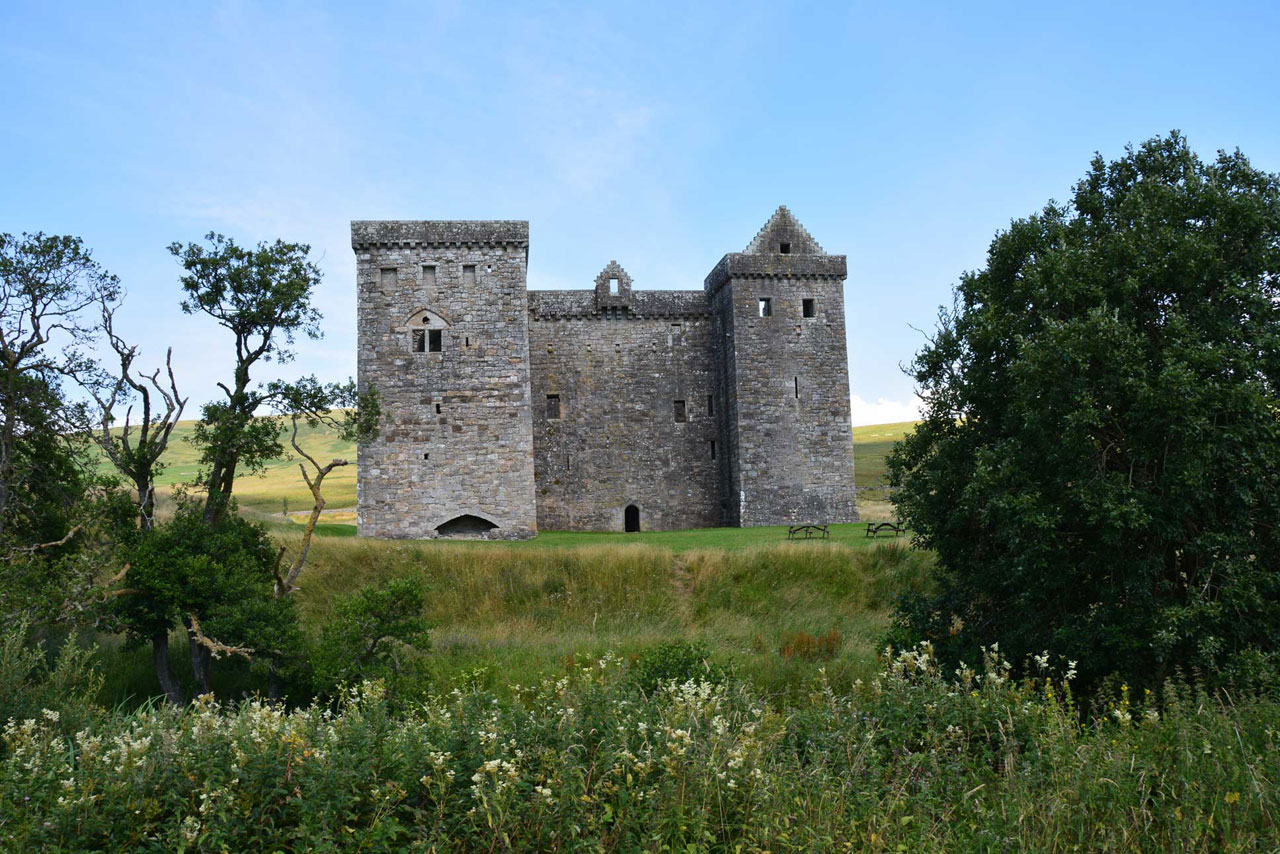
As an important border fortress, Hermitage Castle was fought over and occupied by English and Scottish royalty for centuries. Its location was unique as it guaranteed control of the Scottish Middle March to its occupants for more than 400 years. Often referred to as " the guardhouse of the bloodiest valley in Britain ", the castle's history is filled with tales of torture, treason and murder. Hermitage Castle is now a ruined structure with a daunting appearance and a dark history. The castle is located in Liddesdale, the valley of the Liddel Water, in southern Scotland.
To say that Hermitage Castle is haunted is an understatement. It is believed that every Lord that occupied the castle either died mysteriously, went insane or committed siucide. Visitors to the site come back with countless stories of ghostly encounters and are convinced the castle's history is holding many secrets of tortured souls forced to walk along crumbling corridors for all time.
The most famous castle resident was Sir William de Soulis, who inherited the castle in 1318. He was accused of abducting children, killing them and using their blood in dark magical practices. To help him in his evil dealings he had an assistant familiar called Robin Redcap who promised Soulis that he would not be harmed by forged steel or ever be bound by rope. Eventually the villagers rebelled against Soulis, bound him in chains before wrapping him in lead and throwing him into a boiling cauldron where he met an agonising end. His spirit now wanders the castle often accompanied by heart rendering sobs of children echoing along the eerie corridors.
One of the most active spectres of Hermitage castle is Sir Alexander Ramsay, the Sheriff of Tivetdale, who was held prisoner in the castle by its Lord, Sir William Douglas. According to historical records Ramsay was very good at his job and got too close to Douglas' secret life. Sir William Douglas was suspected to be a follower of Lucifer and practicing black magic, a charge that meant death in its day. When Douglas discovered that the Sherriff was spying on him he was thrown into the rat infested dungeon. Poor Ramsay eventually went mad and starved to death in prison. Visitors have reported hearing a man screaming beneath the castle and others have seen a skeletal spirit roaming about the castle's lower areas.
Finally, the ghost of Mary Queen of Scots is also said to occasionally appear here despite her only having visited Hermitage for a few hours during her lifetime. In October 1566 her trusted noble James Hepburn, 4th Earl of Bothwell, was wounded in a skirmish with cattle thieves and rushed to Hermitage Castle to recover. Mary rode out from Jedburgh to see him but could only stay for a short time, being a married woman. It was said that her two hour visit was a secret lovers' tryst with a man who later became her third husband.
Location: Newcastleton, Hawick TD9 0LU
Official Website: Hermitage Castle
INVERARAY CASTLE
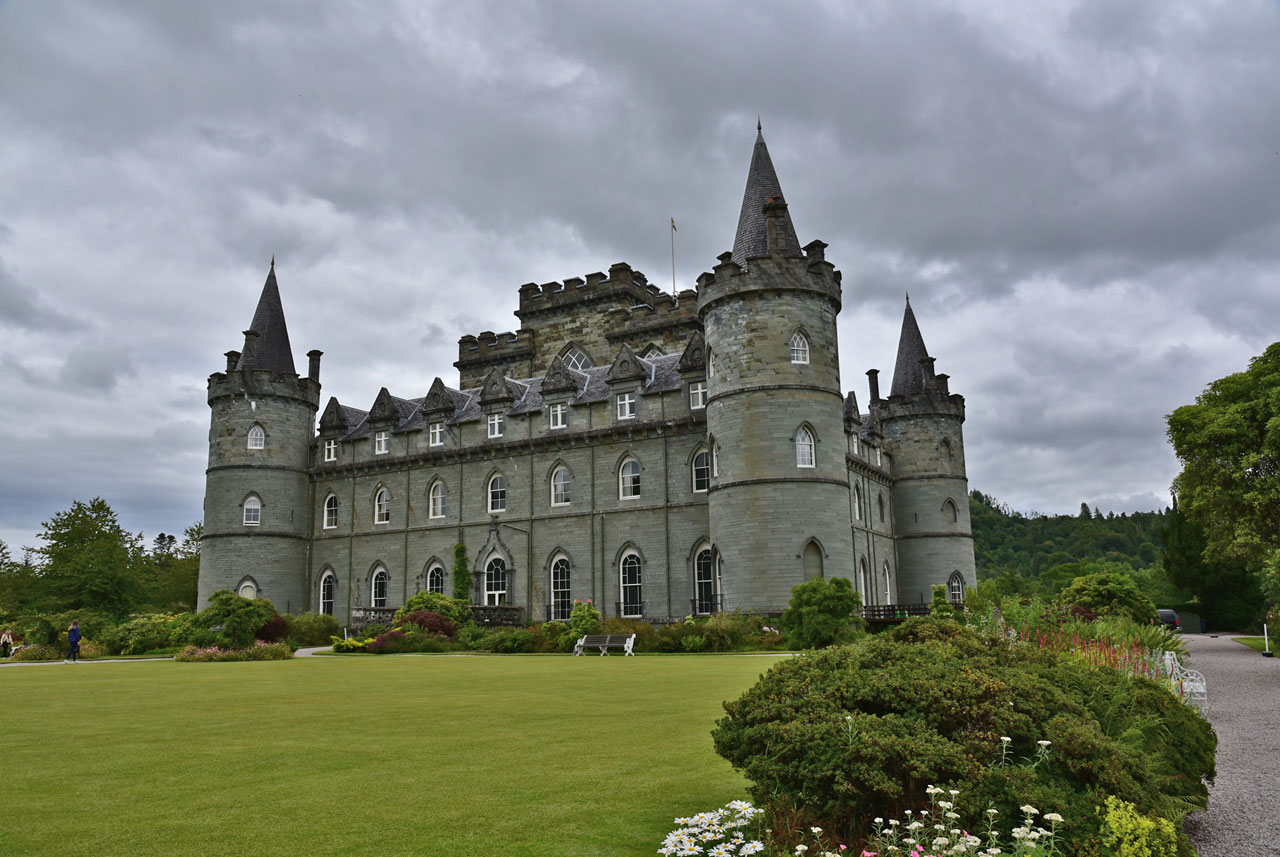
Inveraray Castle in Argyll sits in a magical position overlooking Loch Fyne. It has been the home of the Dukes of Argyll and the seat of the Clan Campbell. A castle has been standing on the shores of Loch Fyne since the 1400s, but the amazing castle you see today was inspired by a sketch by John Vanbrugh, the architect of Castle Howard and Blenheim Palace in the 1700s. But Vanbrugh died and the 3rd Duke of Argyll instructed architects William Adam and Roger Morris to design and build his new castle in the gothic revival style. This work, combined with some other additions in the late 19th century produced what we see now, a beautiful, elegant castle with turrets, towers and conical roofs which looks more like a French chateau than an ancient Scottish stronghold.
The castle has a number of ghosts including the ' Grey Lady' who is only seen by daughters of a Duke of Argyll, the castle's harp player and a floating ship which moves away on the horizon on the death of a Duke.
In 1644, as civil war raged throughout Britain, Inveraray castle was ransacked and burned by Montrose and his army. The brutal attack saw many lose their lives including the castle’s harp player. He was a young irish boy employed as Argyll's personal harp player and the army's large Irish contingent were enraged that one of their kind would work for a Campbell. They killed him and left his dismembered body lying on the Duke of Argyll's bed. It is said that delightful harp melodies could occasionally be heard coming from the bedroom. The ghostly harper has also become a portent of death for the Campbells. When death is near for a member of the Duke's family, faint harp music can be heard along the halls of Inveraray Castle.
Other ghosts are said to drift through the halls of Inveraray Castle, including a mysterious gray lady who only the daughters of the Duke of Argyll can see. Another spirit, the Galley of Lorne, is seen leaving the castle following the death of a Duke. It may be connected to the Ghost Ship of Loch Fyne but nobody is sure. People claim to have seen a phantom ship on the water of Loch Fyne and reports claim that the ship will make its way onto land before disappearing in the direction of Inveraray Castle.
Location: Inveraray PA32 8XE
Official Website: Inveraray Castle
